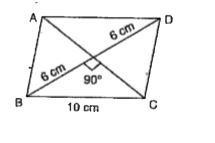One of the four angles of a rhombus is 60∘. If the length of each side of the rhombus is 8 cm, then the length of the longer diagonal is
8√3cm
8 cm
4√3cm
8√3cm
The correct Answer is:A
To find the length of the longer diagonal of a rhombus where one angle is 60∘ and each side measures 8 cm, we can follow these steps:
1. Understanding the Properties of a Rhombus:
A rhombus has diagonals that bisect each other at right angles. The angles of the rhombus can be divided into two equal parts by the diagonals.
2. Identifying the Angles:
Given that one angle of the rhombus is 60∘, the opposite angle is also 60∘. The other two angles will be 120∘ each (since the sum of angles in a quadrilateral is 360∘).
3. Setting Up the Right Triangle:
When we draw the diagonals, they will intersect at point O, creating four right triangles. We will focus on one of the triangles formed by the angle 30∘ (half of 60∘).
4. Using the Sine Function:
In triangle AOB (where A and B are the endpoints of one diagonal), we can use the sine function:
sin(30∘)=OppositeHypotenuse
Here, the opposite side is OC (half of one diagonal), and the hypotenuse is OA (which is the side of the rhombus, 8cm):
sin(30∘)=OCOA⟹12=OC8
Therefore, OC=4cm.
5. Finding the Length of One Diagonal:
Since OC is half of one diagonal AC, the full length of diagonal AC is:
AC=2×OC=2×4=8cm
6. Using the Cosine Function:
Now we will use the cosine function for the triangle to find the other half of the other diagonal BD:
cos(30∘)=AdjacentHypotenuse
Here, the adjacent side is OB (half of the other diagonal), and the hypotenuse is again OA:
cos(30∘)=OB8⟹√32=OB8
Therefore, OB=4√3cm.
7. Finding the Length of the Other Diagonal:
Since OB is half of diagonal BD, the full length of diagonal BD is:
BD=2×OB=2×4√3=8√3cm
8. Conclusion:
The length of the longer diagonal BD is 8√3cm.
Final Answer:
The length of the longer diagonal is 8√3cm.
---
A rhombus has diagonals that bisect each other at right angles. The angles of the rhombus can be divided into two equal parts by the diagonals.
Given that one angle of the rhombus is 60∘, the opposite angle is also 60∘. The other two angles will be 120∘ each (since the sum of angles in a quadrilateral is 360∘).
When we draw the diagonals, they will intersect at point O, creating four right triangles. We will focus on one of the triangles formed by the angle 30∘ (half of 60∘).
In triangle AOB (where A and B are the endpoints of one diagonal), we can use the sine function:
sin(30∘)=OppositeHypotenuse
Here, the opposite side is OC (half of one diagonal), and the hypotenuse is OA (which is the side of the rhombus, 8cm):
sin(30∘)=OCOA⟹12=OC8
Therefore, OC=4cm.
Since OC is half of one diagonal AC, the full length of diagonal AC is:
AC=2×OC=2×4=8cm
Now we will use the cosine function for the triangle to find the other half of the other diagonal BD:
cos(30∘)=AdjacentHypotenuse
Here, the adjacent side is OB (half of the other diagonal), and the hypotenuse is again OA:
cos(30∘)=OB8⟹√32=OB8
Therefore, OB=4√3cm.
Since OB is half of diagonal BD, the full length of diagonal BD is:
BD=2×OB=2×4√3=8√3cm
The length of the longer diagonal BD is 8√3cm.
The length of the longer diagonal is 8√3cm.
Topper's Solved these Questions
- BOOK - KIRAN PUBLICATIONCHAPTER - MENSURATIONEXERCISE - Test Yourself28videos
MENSURATION
- BOOK - KIRAN PUBLICATIONCHAPTER - MENSURATIONEXERCISE - TYPE VI47videos
MENSURATION
- BOOK - KIRAN PUBLICATIONCHAPTER - LCM AND HCF EXERCISE - Test Yourself18videos
LCM AND HCF
- BOOK - KIRAN PUBLICATIONCHAPTER - MISCELLANEOUSEXERCISE - TYPE-VI15videos
MISCELLANEOUS
Similar Questions
Knowledge Check
- Question 1 - Select One
One diagonal of a rhombus is half the other. If the length of the side of the rhombus is 20 cm, what is the area of the rhombus ?
A320 square cm.B160 sqaure cm.C240 square cmD360 square cm. - Question 2 - Select One
The measure of each of the two opposite angles of a rhombus is 60° and the measure of one of its sides is 10 cm. The length of its smaller diagonal is
A10 cmB10√3 cmC10√2 cmD52√2 cm - Question 3 - Select One
The measure of each of two opposite angles of a rhombus is 60∘ and the measure of one of its sides is 10 cm. The length of its smaller diagonal is :
A10 cmB10√3cmC10√2cmD52√2cm
The area of a rhombus is 150 cm2. The length of one of its diagonal is 10 cm. What is the length of the other diagonal ?
View SolutionThe area of a rhombus is 132 cm2. If length of one of its diagonals is 11 cm, then what is the length of the other diagonal?
View SolutionIf the diagonals of a rhombus are 30 cm and 40 cm, then the length of each side of rhombus is
View SolutionThe perimeter of a rhombus is 40 cm. If the length of one of its diagonal is 10 cm, what is the length of the other diagonal?
 View Solution
View SolutionThe diagonals of a rhombus are 10 cm and 24 cm. Find the length of a side of the rhombus.
View Solution

